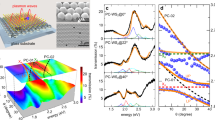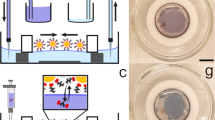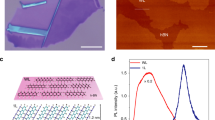Abstract
Much effort over the past decades has been focused on improving carrier mobility in organic thin-film transistors by optimizing the organization of the material or the device architecture. Here we take a different path to solving this problem, by injecting carriers into states that are hybridized to the vacuum electromagnetic field. To test this idea, organic semiconductors were strongly coupled to plasmonic modes to form coherent states that can extend over as many as 105 molecules and should thereby favour conductivity. Experiments show that indeed the current does increase by an order of magnitude at resonance in the coupled state, reflecting mostly a change in field-effect mobility. A theoretical quantum model confirms the delocalization of the wavefunctions of the hybridized states and its effect on the conductivity. Our findings illustrate the potential of engineering the vacuum electromagnetic environment to modify and to improve properties of materials.
This is a preview of subscription content, access via your institution
Access options
Subscribe to this journal
Receive 12 print issues and online access
$259.00 per year
only $21.58 per issue
Buy this article
- Purchase on Springer Link
- Instant access to full article PDF
Prices may be subject to local taxes which are calculated during checkout




Similar content being viewed by others
References
Haroche, S. in Fundamental Systems in Quantum Optics (eds Dalibard, J., Raimond, J. M. & Zinn-Justin, J.) (North Holland, 1992).
Houdré, R. Early stage of continuous wave experiments on cavity-polaritons. Phys. Status Solidi B 242, 2167–2196 (2005).
Vasa, P. et al. Real-time observation of ultrafast Rabi oscillations between excitons and plasmons in metal nanostructures with J-aggregates. Nature Photon. 7, 128–132 (2013).
Agranovich, V. M. & Malshukov, A. G. Surface polariton spectra if the resonance with the transition layer vibrations exist. Opt. Commun. 11, 169–171 (1974).
Strashko, A. A. & Agranovich, V. M. To the theory of surface plasmon–polaritons on metals covered with resonant thin films. Opt. Commun. 332, 201–205 (2014).
Schwartz, T., Hutchison, J. A., Genet, C. & Ebbesen, T. W. Reversible switching of ultra-strong coupling. Phys. Rev. Lett. 106, 196405 (2011).
Kéna-Cohen, S., Maier, S. A. & Bradley, D. D. C. Ultrastrongly coupled exciton–polaritons in metal-clad organic semiconductor microcavities. Adv. Opt. Mater. 1, 827–833 (2013).
Hutchison, J. A., Schwartz, T., Genet, C., Devaux, E. & Ebbesen, T. W. Modifying chemical landscapes by coupling to the vacuum fields. Angew. Chem. Int. Ed. 51, 1592–1596 (2012).
Hutchison, J. A. et al. Tuning the work-function via strong coupling. Adv. Mater. 25, 2481–2485 (2013).
Canaguier-Durand, A. et al. Thermodynamics of molecules strongly coupled to the vacuum field. Angew. Chem. Int. Ed. 52, 10533–10536 (2013).
Aberra Guebrou, S. et al. Coherent emission from a disordered organic semiconductor induced by strong coupling to surface plasmons. Phys. Rev. Lett. 108, 066401 (2012).
Deng, H., Haug, H. & Yamamoto, Y. Exciton–polariton Bose–Einstein condensation. Rev. Mod. Phys. 82, 1490–1537 (2010).
Kasprzak, J. et al. Bose–Einstein condensation of exciton polaritons. Nature 443, 409–414 (2006).
Kéna-Cohen, S. & Forrest, S. R. Room-temperature polariton lasing in an organic single-crystal microcavity. Nature Photon. 4, 371–375 (2010).
Ballarini, D. et al. All-optical polariton transistor. Nature Commun. 4, 1778 (2013).
Tanese, D. et al. Polariton condensation in solitonic gap states in a one-dimensional periodic potential. Nature Commun. 4, 1749 (2013).
Plumhof, J. D., Stöferle, T., Mai, L., Scherf, U. & Mahrt, R. F. Room-temperature Bose–Einstein condensation of cavity exciton–polaritons in a polymer. Nature Mater. 13, 247–252 (2014).
Sapienza, L. et al. Electrically injected cavity polaritons. Phys. Rev. Lett. 100, 136806 (2008).
De Liberato, S. & Ciuti, C. Quantum theory of electron tunneling into intersubband cavity polariton states. Phys. Rev. B 79, 075317 (2009).
González-Tudela, A., Huidobro, P. A., Martín-Moreno, L., Tejedor, C. & García-Vidal, F. J. Theory of strong coupling between quantum emitters and propagating surface plasmons. Phys. Rev. Lett. 110, 126801 (2013).
Tsintzos, S. I., Pelekanos, N. T., Konstantinidis, G., Hatzopoulos, Z. & Savvidis, P. G. A GaAs polariton light-emitting diode operating near room temperature. Nature 453, 372–375 (2013).
Bhattacharya, P., Xiao, B., Bhowmick, S. & Heo, J. Solid state electrically inject exciton–polariton laser. Phys. Rev. Lett. 110, 206403 (2013).
Schneider, C. et al. An electrically pumped polariton laser. Nature 497, 348–352 (2013).
Tischler, J. R., Bradley, M. S., Bulovic, V., Song, J. H. & Nurmikko, A. Strong coupling in a microcavity LED. Phys. Rev. Lett. 95, 036401 (2005).
Shi, L. et al. Spatial coherence properties of organic molecules coupled to plasmonic surface lattice resonances in the weak and strong coupling regimes. Phys. Rev. Lett. 112, 153002 (2014).
Shirakawa, H., Louis, E. J., MacDiarmid, A. G., Chiang, C. K. & Heeger, A. J. Synthesis of electrically conducting organic polymers: Halogen derivatives of polyacetylene, (CH). Chem. Commun. 16, 578–580 (1977).
Tang, C. W. & VanSlyke, S. A. Organic electroluminescent diodes. Appl. Phys. Lett. 51, 913–915 (1987).
Burroughs, J. H. et al. Light emitting diodes based on conjugated polymers. Nature 347, 539–541 (1990).
Kim, C., Burrows, P. E. & Forrest, S. R. Micropatterning of organic electronic devices by cold-welding. Science 288, 831–833 (2000).
Forrest, S. R. The path to ubiquitous and low-cost organic electronic appliances on plastic. Nature 428, 911–918 (2004).
Kahn, A., Koch, N. & Gao, J. Electronic structure and electrical properties of interfaces between metals and p-conjugated molecular films. Polym. Sci. Polym. Phys. 41, 2529–2548 (2003).
Sirringhaus, H., Bird, M., Richards, T. & Zhao, N. Charge transport physics of conjugated polymer field-effect transistors. Adv. Mater. 22, 3893–3898 (2010).
Arias, A. C., Mackenzie, J. D., McCulloch, I., Rivnay, J. & Salleo, A. Materials and applications for large area electronics: Solution-based approaches. Chem. Rev. 110, 3–24 (2010).
Yan, H. et al. A high mobility electron transporting polymer for printed transistors. Nature 457, 679–687 (2009).
Jones, B. A. et al. High-mobility air-stable n-type semiconductors with processing versatility: Dicyanoperylene-3,4:9,10-bis (dicarboximides). Angew. Chem. Int. Ed. 116, 6523–6526 (2004).
Jones, B. A., Facchetti, A., Wasielewski, M. R. & Marks, T. J. Tuning orbital energetics in arylene diimide semiconductors. Materials design for ambient stability of n-type charge transport. J. Am. Chem. Soc. 129, 15259–15278 (2007).
Ebbesen, T. W., Lezec, H. J., Ghaemi, H. F., Thio, T. & Wolff, P. A. Extraordinary optical transmission through sub-wavelength hole arrays. Nature 391, 667–669 (1998).
Rodrigo, S., García-Vidal, F. J. & Martín-Moreno, L. Influence of material properties on extraordinary optical transmission through hole arrays. Phys. Rev. B 77, 075401 (2008).
Przybilla, F., Genet, C. & Ebbesen, T. W. Long vs. short-range orders in random subwavelength hole arrays. Opt. Express 20, 4697–4709 (2012).
Archambault, A., Marquier, F., Greffet, J.-J. & Arnaud, C. Quantum theory of spontaneous and stimulated emission of surface plasmons. Phys. Rev. B 82, 035411 (2010).
Lagendijk, A., van Tiggelen, B. & Wiersma, D. S. Fifty years of Anderson localization. Phys. Today 62, 24–29 (August, 2009).
Feist, J. & García-Vidal, F. J. Extraordinary exciton conductance induced by strong coupling. Phys. Rev. Lett. 114, 196402 (2015).
Schachenmayer, J., Genes, C., Tignone, E. & Pupillo, G. Cavity-enhanced transport of excitons. Phys. Rev. Lett. 114, 196403 (2015).
Kibis, O. V. How to suppress the backscattering of conduction electrons? Europhys. Lett. 107, 57003 (2014).
Morina, S., Kibis, O. V., Pervishko, A. A. & Shelykh, I. A. Transport properties of a two-dimensional electron gas dressed by light. Phys. Rev. B 91, 155312 (2015).
Yan, H. et al. A high-mobility electron-transporting polymer for printed transistors. Nature 457, 679–686 (2009).
Mori, D. et al. Highly efficient charge-carrier generation and collection in polymer/polymer blend solar cells with a power conversion efficiency of 5.7%. Energy Environ. Sci. 7, 2939–2943 (2014).
Acknowledgements
This work was supported in part by USIAS, the ERC through the projects Plasmonics (227557), Suprafunction (257305), and Coldsim (307688), the International Center for Frontier Research in Chemistry (icFRC, Strasbourg), the ANR Equipex Union (ANR-10-EQPX-52-01), the Labex NIE projects (ANR-11-LABX-0058 NIE) and CSC (ANR-10-LABX-0026 CSC) within the Investissement d’Avenir program ANR-10-IDEX-0002-02, RYSQ, as well as the NSF (PIF-1211914 and PFC-1125844), EOARD (FA8655-13-1-3032) and the Austrian Science Fund (FWF) via the project P24968-N27. Computations made use of the Janus supercomputer, supported by NSF (CNS-0821794), NCAR and CU Boulder/Denver.
Author information
Authors and Affiliations
Contributions
T.W.E. conceived the idea and supervised the project. T.W.E. and E.O. designed the device experiments. J.G., J.A.H. and E.D. undertook the spectroscopic experiments. E.D., E.O., J.G., J.A.H. and J.F.D. fabricated and performed the device experiments. B.D., P.S., C. Genet and F.S. helped with the interpretation of the experimental data. G.P., C. Genes and J.S. developed the theoretical framework and performed the simulations. All authors contributed to the discussions and the preparation of the manuscript.
Corresponding author
Ethics declarations
Competing interests
The authors declare no competing financial interests.
Supplementary information
Supplementary Information
Supplementary Information (PDF 1087 kb)
Rights and permissions
About this article
Cite this article
Orgiu, E., George, J., Hutchison, J. et al. Conductivity in organic semiconductors hybridized with the vacuum field. Nature Mater 14, 1123–1129 (2015). https://doi.org/10.1038/nmat4392
Received:
Accepted:
Published:
Issue Date:
DOI: https://doi.org/10.1038/nmat4392
This article is cited by
-
Electronic transport driven by collective light-matter coupled states in a quantum device
Nature Communications (2023)
-
Engineering random spin models with atoms in a high-finesse cavity
Nature Physics (2023)
-
Controlling the electro-optic response of a semiconducting perovskite coupled to a phonon-resonant cavity
Light: Science & Applications (2023)
-
Spectral engineering of cavity-protected polaritons in an atomic ensemble
Nature Physics (2023)
-
Ultrafast imaging of polariton propagation and interactions
Nature Communications (2023)



